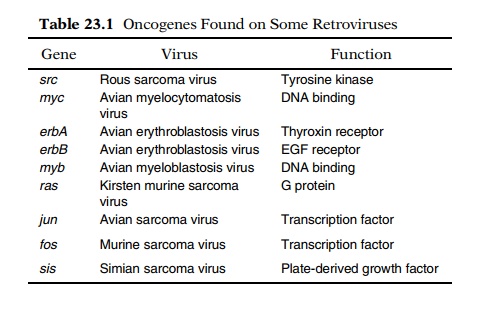Chapter: Genetics and Molecular Biology: Oncogenesis, Molecular Aspects
Cellular Counterparts of Retroviral Oncogenes
Cellular Counterparts of Retroviral Oncogenes
Are the viral oncogenes of acutely transforming
viruses related to any cellular genes? This is a good question for a number of
reasons. Since chromosomal rearrangements point to specific genes as being
involved in transformation to the cancerous state, genes related to these may
be carried on the retroviruses. Also, since cancer can be induced by mutagens,
it would seem likely that the mutations responsible could alter cellular genes
to resemble their analogs carried on the acutely transforming retroviruses.
Finally, a slow retrovirus occasionally be-comes acutely transforming by the
substitution of part of its genetic material by host material. Most likely the
new gene originates from the chromosome of the cells in which the virus has
been growing.
The question as to whether the viral oncogenes are
related to cellular genes can easily be answered by Southern transfers. Undue
fears of dangers from cloning such DNAs have long passed, and viral oncogenes
may now be handled, at least in the United States, without unnecessarily
elaborate precautions. The viral oncogenes from a number of retroviruses have
been cloned from the virus into plasmid or phage vectors. Then the appropriate
restriction fragments have been used to probe Southern transfers of DNA
extracted from noncancerous animals. Most surprisingly, chickens, mice, and
humans all possess a sequence of DNA with high homology to the src gene. Clearly this gene has not
evolved rapidly in the time since these animals diverged from one another. This
implies that the cellular function of this protein is funda-mental and closely
tied to other cellular functions so that its further evolution is frozen.
The viral form of the src gene is called v-src
and the cellular form is c-src.
Homology measurements similar to those carried out for Roussarcoma virus have
been done for other acutely transforming retroviruses (Table 23.1). Most of the
viral oncogenes in these viruses possess cellular counterparts as well. About
50 different viral and cellular forms of the oncogenes are known. This means
that a reasonably

small number of genes are involved in regulating
cell growth and that there is some hope of being able to deduce how the
products of these genes function in normal and transformed cells.
The mutated gene that Weinberg found in the human
bladder carci-noma cells is carried in a slightly modified form on a
rat-derived Harvey murine sarcoma virus. It is called H-ras. The myc gene which
translo-cates into the heavy chain locus of the immunoglobulin genes in
Burkitt’s lymphoma, has also been identified on a retrovirus. Thus the same
proto-oncogene can be activated through various cellular or viral mechanisms.
Related Topics